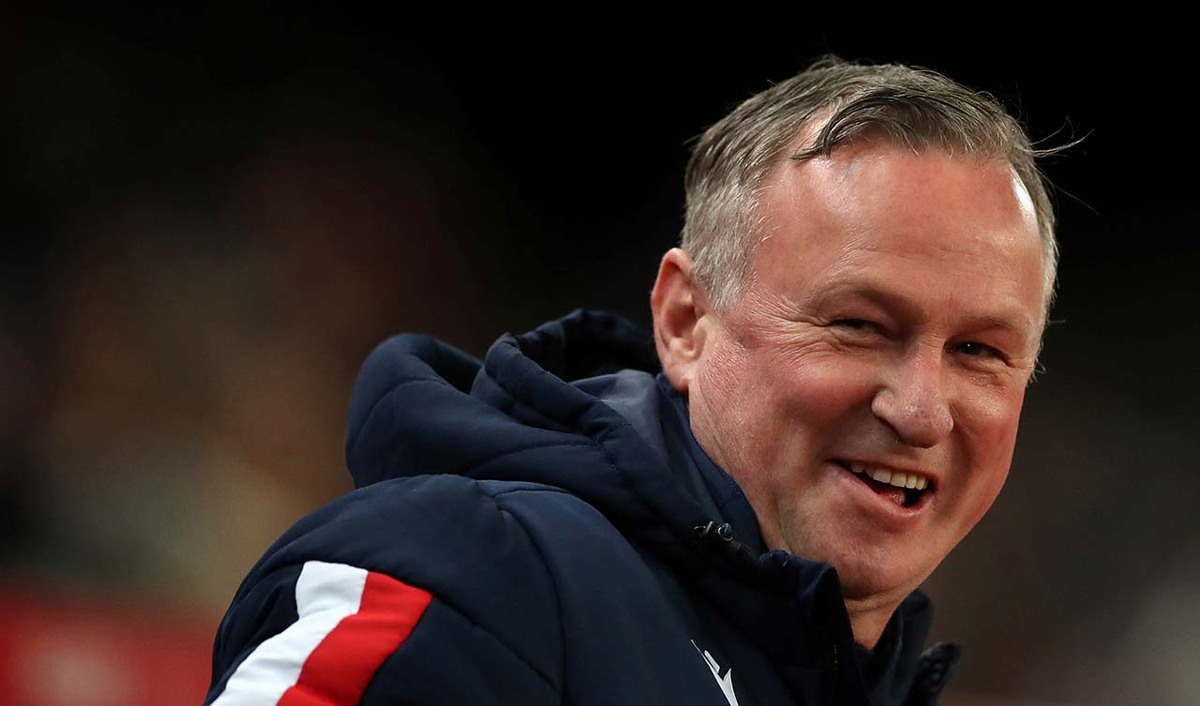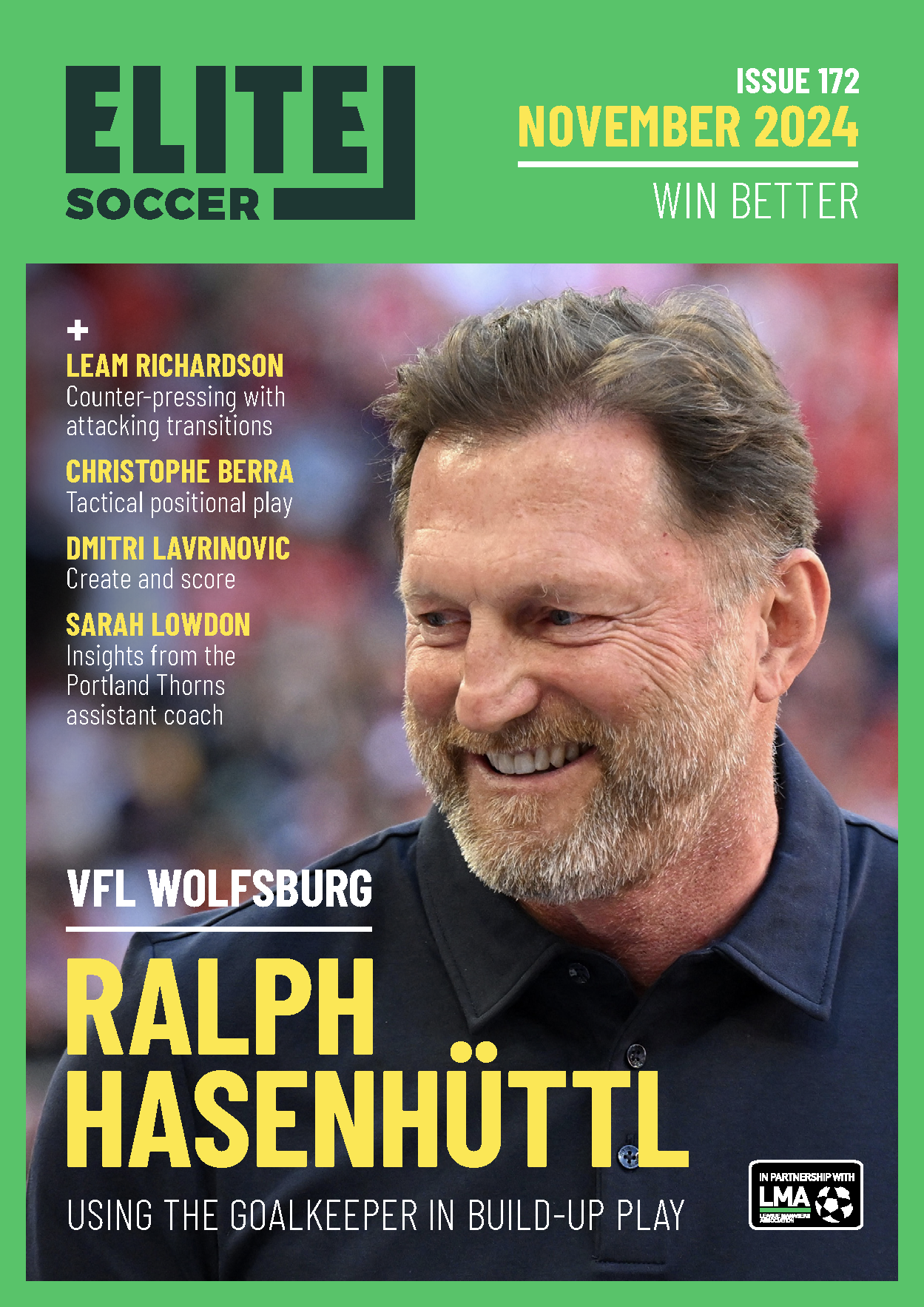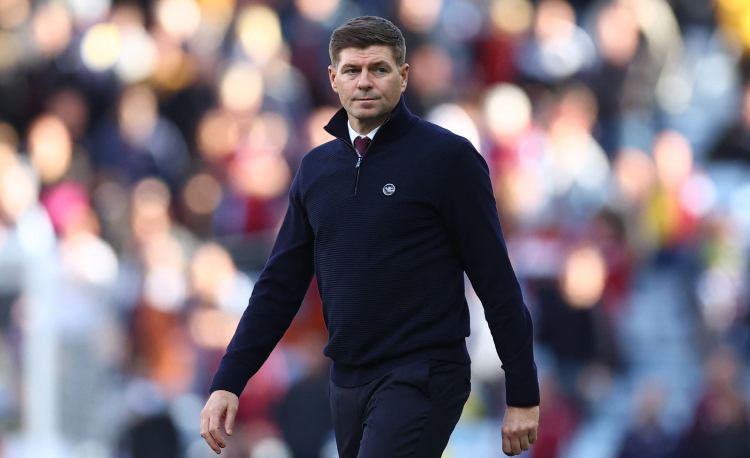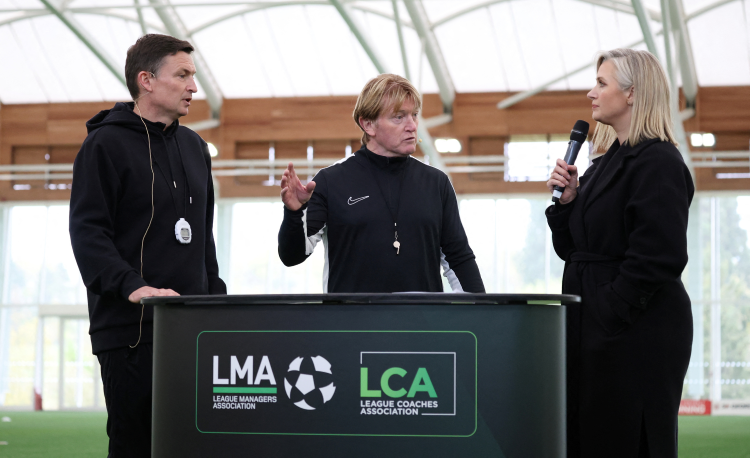You are viewing 1 of your 1 free articles
Positive pockets
The session is about playing into positive pockets behind the opposition midfield upon regain of possession.
| Area | Use of a full pitch |
| Equipment | Balls, cones, goals, mannequins, mini-goals |
| No. of Players | Up to 22 |
| Session Time | 75mins each |
The session is about playing into positive pockets behind the opposition midfield upon regain of possession. For a team such as ours, where the sum is greater than our parts, each session is specifically opponent-focused and normally involves playing to our attacking strengths and opponents’ defensive weaknesses.
For instance, we worked on positive pockets in preparation for our match against Faroe Islands who we believed to be a misunderstood opponent. Analysis led us to realise that possession equalling success versus the Faroes was a myth. Instead, we found that they lost 80% of their goals from moves of a possession phase of fewer than five passes. Long periods of possession therefore reduced our chances of scoring, while positive pockets encouraged accelerated, dynamic attacks.
So upon turnover we needed to have a trained process of getting players quickly into positive pockets behind the midfield, and finding those players - notably Oliver Norwood and Steven Davis - within one or two passes.
This session moves from training in isolation through the coached phase, to ending with the players finding the moment in the game.
We would run this session four days before the game and the workload broadly comes in at 5,500-6,500 metres, with 30-50 accelerations/decelerations. Any nearer the game and there would be a danger of fatigue.
What do I get the players to do?
Warm-up (not shown)
(15mins)
One of our coaches will run a conventional warm-up to get players ready both physically and mentally.
Stage 1
(12mins, 90secs x 4, two groups)
Setting up as shown (1), this is 4v4 in the box. After two passes players can then transfer to the grey player in the centre, then go to support the ball in the opposite box. If successful, the team maintains possession; if not the other team keeps the ball and then takes up the task themselves.
1
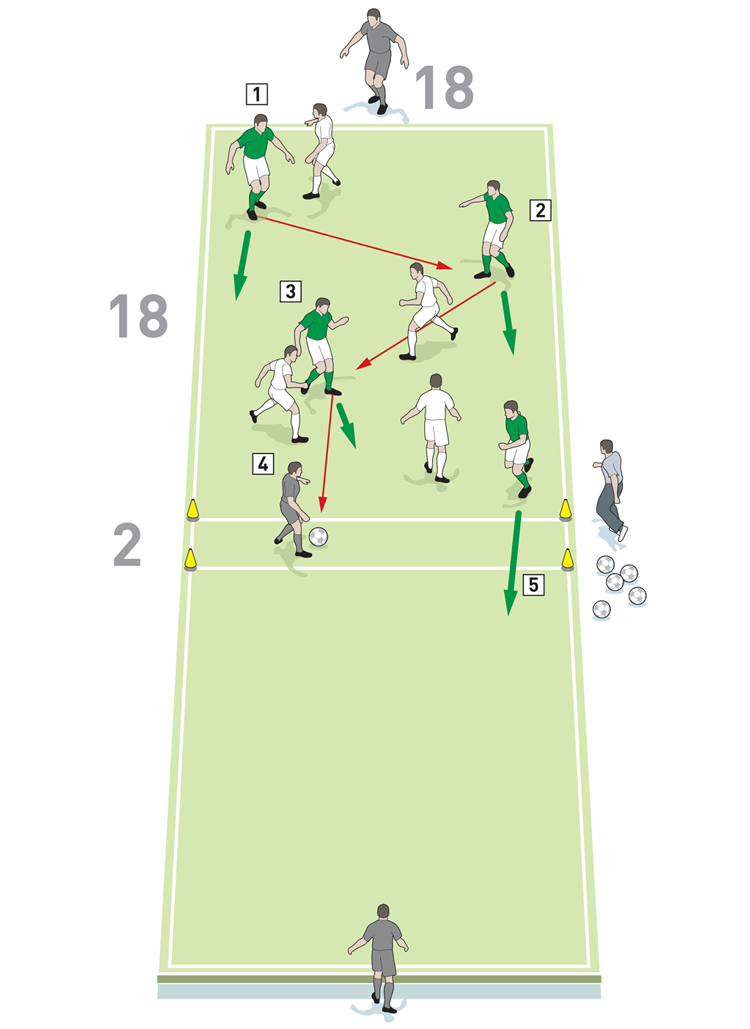
2. Short, measured passes are made
3. Here, the man in the pocket occupies a space in between opponents, and he will always try to move the ball on into a key area within one or two passes
4. Grey receives and holds up play waiting for players to transfer into the bottom area
5. This supporting green is the first player to move
What are the key things to look out for?
Players for the team in possession are encouraged to find ‘the pocket’ in between opponents before transferring - they need to volunteer to move into tight possession areas.
Grey players must work off the angles to facilitate movement of the ball from one end of the area to the other.
Pass restrictions can be removed as players become more adept, but rarely can the transfer be rapid as the team with possession needs time to move across into the empty space.
Stage 2
(18mins, two groups with rotation)
Setting up as shown (2), the ball starts with the defensive midfielder, who chooses the full-back with an initial deep pass. The ball is then played into the pocket - where mannequins represent opponents - for the attacking central midfielder. When he receives and turns this is the trigger for a team mate to break the line from wide. This is in keeping with getting the ball there in two passes.
2
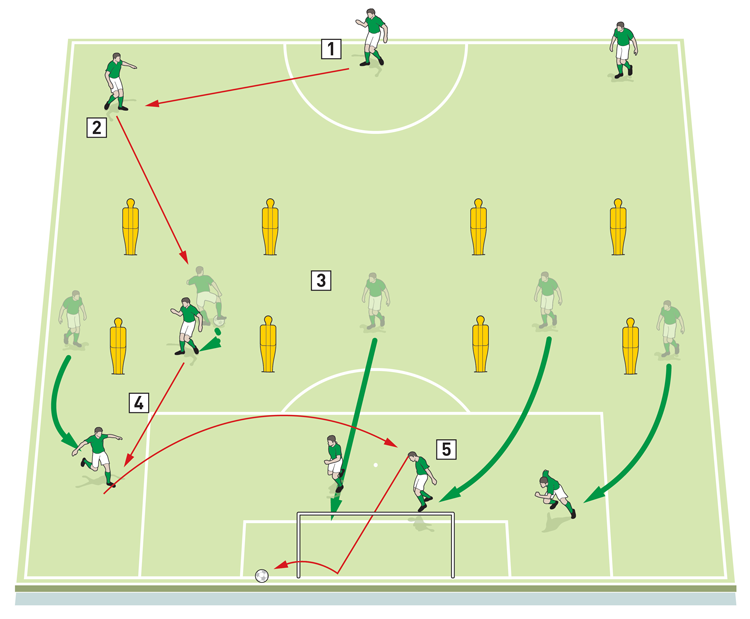
2. A pass is played into the pocket
3. The pocket is represented by the space in the middle of the mannequins
4. The pocket player receives on the half turn and, within one or two touches, passes to his overlapping winger
5. Players progress from the midfield area and attack the goal
When the winger has broken the line and received, it’s the cue for our three key attacking players to ‘hit the box’.
While the pocket player’s instruction is simple - he must make a positive, attacking pass in one or two touches - we still want to explore ways of developing the role of the wide player. We can do this either by encouraging him inside (for a direct run on goal) or recommending he goes outside the full-back. In an instance where the midfielder is ‘low’ and cannot make it into the pocket, we would expect the wide player to drift in to occupy that space.
Stage 3 (15mins)
Setting up as shown we organise with eight attackers and three defenders (3). The ball starts with the defensive midfielder who chooses the full-back with an initial deep pass. The game is then played within the lines of the box with players encouraged to come into the pocket (with the mannequins acting as outside midfielders in a four) and make runs ‘from out to in’ leaving the gap for the full-back.
3
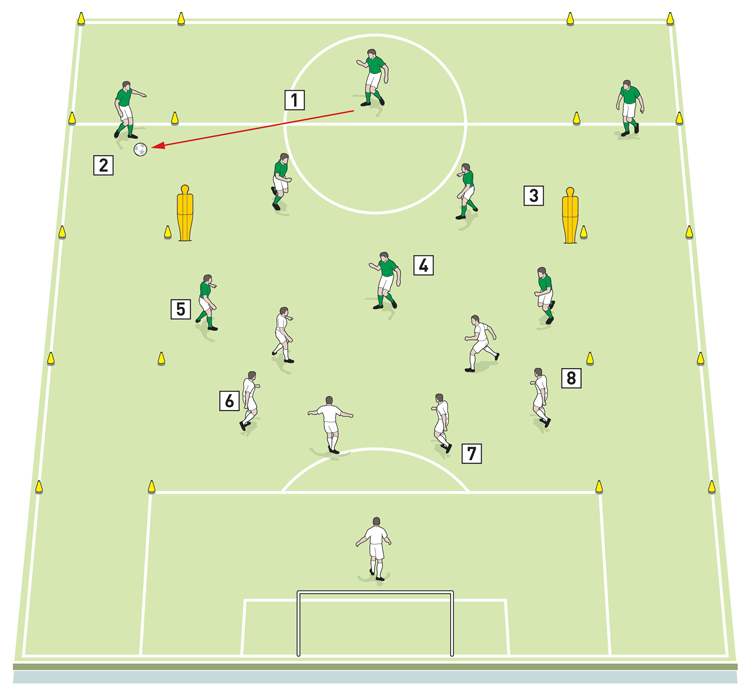
2. The full-back will now pass the ball diagonally into the midfield area, then edges forward, but must remain in his wide channel at all times
3. The two static mannequins and two moving midfielders create the pocket that one opposing green needs to penetrate
4. If this attacking midfielder finds the pocket the wide players, left and right of him, retain their width
5. If in a different attack this wide player is the man to find the pocket, we want to see the full-back progressing further up the wing than he usually would given that he is now responsible for adding width
6. Opposition full-backs are drawn into the pocket
7. Centre-backs become isolated against our incoming attacking players 8. Opposition full-backs are drawn into the pocket
Players can only ‘activate’ an attack when they receive the ball within the lines of the mannequins.
If an attacking midfielder finds this pocket then the wide player keeps his width; if the wide player finds the pocket, the full-back is responsible for the width.
The aim here is to try to move the opposition full-backs into the pocket, leaving their centre-backs engaged with our striker. If a full-back is engaged the defensive unit becomes so narrow that the wide player can break lines centrally, or the full-back can be in a high position to cross.
Stage 4 (15mins)
Setting up as shown with a 9v8 and opposition midfielders replacing the mannequins (4), the first attack allows the pocket to activate the route forward. Except now the second ball represents a situation in a live game whereby whites, upon regains, look for the mini-goals, giving the game shape and inviting a competition element. This allows space to find pockets.
4
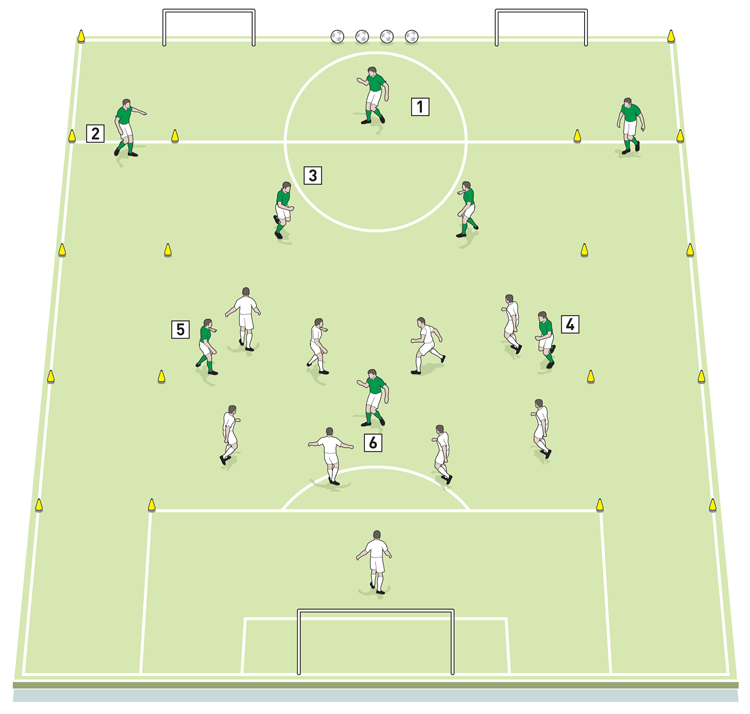
2. Full-backs must be ready to advance up the wing
3. Defenders hold back, alert to the threat of a counter-attack should the pocket fail
4. A wide player not in a pocket must be ready to make an attacking run into the box
5. The wide player can easily drift across into his own pocket
6. The green player finds the pocket between two banks of whites
The match element invites players to find pockets in different areas as well as well as allowing the space for more to develop naturally.
The ball must go into the positive pocket within three passes of possession being regained (which means the player must be ready in the pocket within two). When in there it’s likely, at first, players will choose to feed the wide player, but as a game progresses they will grow more comfortable in the role and will discover central situations where the pocket is most open.
What are the key things to look out for?
Where technical play is concerned we want to see receiving on the back foot and on the half-turn, and players checking over their shoulders as the ball comes in to them. Hips should be facing towards the goals and the intention should always be to pass up the pitch. Finally, players should not stop the ball – they should always be on the move with it.
For tactical observations players must never make square passes on a turnover as these allow the opposition to get back and cement defensive shape,and must be clear as to whether they should get to the pocket or play into the pocket. The man in the pocket should never play backwards, and we want to see attacks finished in five passes.
We want to encourage players to be positive, not just in retaining the ball but in feeling able to take the risk of losing it with shots, crosses and dribbles. In some matches the mistake is actually in not taking the risk though this may vary depending on the opposition, scoreline or game plan.
Related Files
Editor's Picks
Using the goalkeeper in build-up play
Pressing principles
Intensive boxes drill with goals
Penetrating the final third
Creating and finishing
My philosophy
Pressing initiation
Compact team movement
Defensive organisation
Coaches' Testimonials

Alan Pardew

Arsène Wenger

Brendan Rodgers

Carlos Carvalhal

José Mourinho

Jürgen Klopp

Pep Guardiola

Roy Hodgson

Sir Alex Ferguson

Steven Gerrard
Related
Principles in possession
Coaches' Testimonials

Gerald Kearney, Downtown Las Vegas Soccer Club

Paul Butler, Florida, USA

Rick Shields, Springboro, USA

Tony Green, Pierrefonds Titans, Quebec, Canada
Join the world's leading coaches and managers and discover for yourself one of the best kept secrets in coaching. No other training tool on the planet is written or read by the calibre of names you’ll find in Elite Soccer.
In a recent survey 92% of subscribers said Elite Soccer makes them more confident, 89% said it makes them a more effective coach and 91% said it makes them more inspired.
Get Monthly Inspiration
All the latest techniques and approaches
Since 2010 Elite Soccer has given subscribers exclusive insight into the training ground practices of the world’s best coaches. Published in partnership with the League Managers Association we have unparalleled access to the leading lights in the English leagues, as well as a host of international managers.
Elite Soccer exclusively features sessions written by the coaches themselves. There are no observed sessions and no sessions “in the style of”, just first-hand advice delivered direct to you from the coach.
